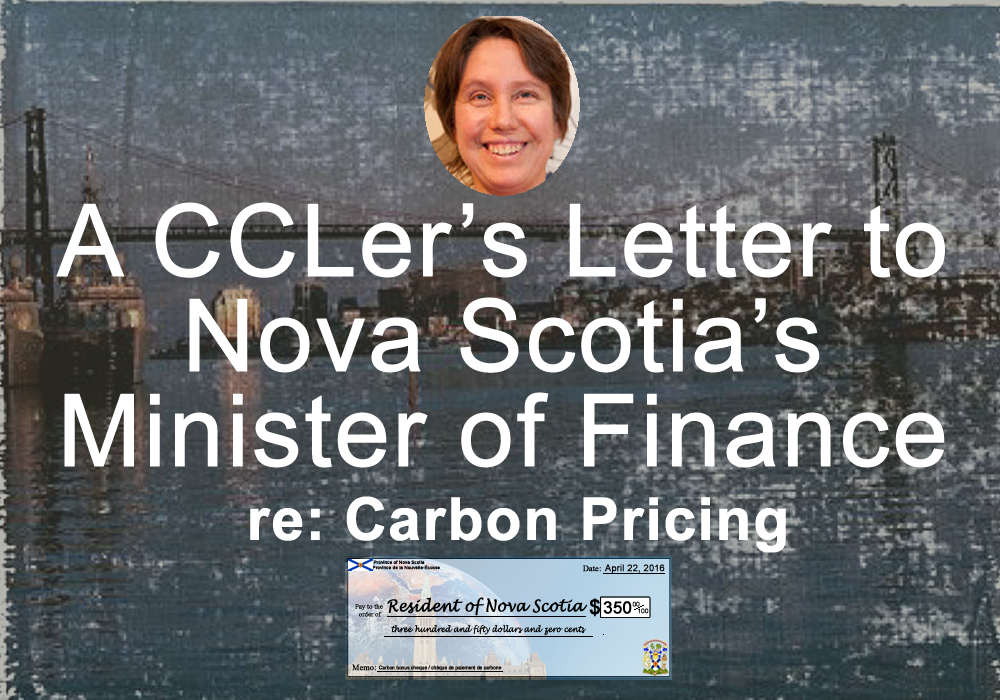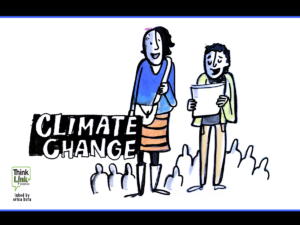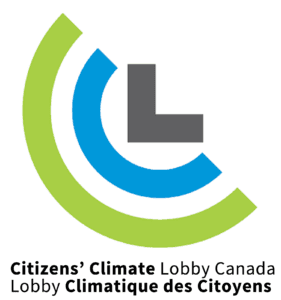
To: The Honouarble Randy Delorey
From: Citizens’ Climate Lobby, Canada – Halifax
Re: Upcoming budget, Carbon pricing
Dear Mr. Delorey,
Thank you very much for your commitment to our province and your hard work to improve things for Nova Scotians. I particularly thank you for meeting with our group last month to discuss carbon pricing, as well as inviting us to write to you about the upcoming budget. And thank you for bring the knowledge and spirit from COP21 to your new role as finance minister.
We know that carbon pricing is coming as a country. This is our opportunity to pick the method of pricing that will help our province/region the most. I understand that it may be most effective to have one carbon pricing scheme for Atlantic Canada. Let’s keep talking with the other Atlantic provinces and together get a plan soon, to help all of us. Shawn McCarthy in The Globe and Mail said last week that Ottawa intends to have a nation-wide carbon pricing soon.[1] Let us lead our region in the discussion and action to get Canada back.
I want to start by setting out 4 principles that are important in assessing any carbon pricing method. I will call these Citizens’ Climate Lobby – Halifax (CCL-Hfx) criteria.
Firstly, it needs to be effective. The pricing needs to lead to businesses and citizens choosing to limit GHG emissions. The Federal Government has said we need the planet to limit warming to 1.5ºC. And Nova Scotia is quite at risk for the effects of global warming, be it sea level rise, hurricane increases or crazy winters like last one. For us to hold to that limit economists such as Dave Sawyer show that we need to raise our carbon pricing to $150-180/tonne by 2030.[2] The price can start moderately small, but needs to rise rather quickly to get to that level. Therefore, it is important to pick a method of pricing that can do that.
Secondly, our carbon pricing plan needs to be fair. Many Nova Scotians are struggling financially. Any carbon pricing scheme should not be instituted on the backs of the poor, including the working poor. Carbon pricing will increase prices of gasoline, home heating oil, food, and anything moved in Nova Scotia. It also should include all forms of fossil fuel emissions, rather than picking and choosing between different industries. Please be aware of low/middle income Nova Scotians when you look at different schemes.
Thirdly, let’s have a cost-effective and efficient form of pricing. The more complicated a pricing form is, the more it will cost to administer. Administrative costs are an important pro/con to consider when looking at different plans.
Fourthly, any method should be transparent to all parties – those corporations paying the bulk of the costs, those businesses paying smaller parts but still paying, and individuals in Nova Scotia, both those at the upper end of the income scale and those at the lower end. Different schemes are very different in terms of their transparency factor.
These principles are similar to the ones that Elizabeth Beale of the Eco-fiscal Commission outlined in her talk at Dalhousie University in January.[3] Her 5 principles are the following:
1) Broad coverage is essential, and who pays matters.
2) Will this be a new revenue source, or will it be revenue neutral?
3) The cap or carbon price has to be sufficiently stringent to ensure a decrease in emissions.
4) Revenue recycling will depend on needs of individual jurisdictions. She said as electricity costs in Nova Scotia are almost the highest in Canada that Nova Scotia would need to allocate more money to low income people or there will be much greater inequality.
5) How to help vulnerable sectors adjust can be tricky, but it is not impossible. There can be temporary rebates or other assistance for specific sectors.
Keeping these principles in mind, both from Citizens’ Climate Lobby (CCL) and from Elizabeth Beale, I will make the argument why Nova Scotia (the Atlantic provinces) should choose Carbon Fee and Dividend for our carbon pricing scheme. The first reason is that this will be good politics, reframing the discussion of carbon pricing from a tax to a dividend for residents. As economist at Dalhousie University Lars Osberg says:
The Carbon Fee and Dividend proposal is that a fee or carbon price be charged per ton of CO2 equivalent emissions for all greenhouse gas emissions and that all fee revenue would be refunded as an equal cash dividend to all citizens3. It is framed as a “fee” rather than as a “tax” because the underlying idea is enforcing compensation for a property right4 – it is not taxation, whose purpose is to transfer resources to the control of government. The moral rationale is that collectively, we all own the air, so those who use and degrade the air (i.e. GHG emitters) should compensate those who own it (i.e. citizens) for the damage they are causing. By reframing carbon fee revenue as deserved compensation for degradation of the property of citizens, a CFD shifts the focus of debate fundamentally.5 It therefore has a crucial advantage over other carbon pricing proposals – it just may catch the imagination of enough voters to become good politics, as well as good policy.
Previous superscript 3, 4 and 5 are his footnotes. See his paper p.3[4]
As you can see, that would make carbon pricing more palatable for all voters, both lower and higher income ones.
The Carbon Fee and Dividend proposal does well on the four CCL-Hfx criteria, as will as on Elizabeth Beale’s criteria (E.B.) on which any carbon pricing should be evaluated.
CCL-Hfx 1) Effectiveness: Carbon Fee and Dividend can be incredibly effective if it starts at a relatively low price and rises steadily. The government will continue to have support from residents to keep raising it as they are getting dividends of increasing size. It will be attractive to industry as it is predictable. This criterion is the same as Elizabeth Beale’s third one. This also overlaps with Elizabeth Beale’s first one: Who pays matters. Carbon Fee and Dividend would be applied at the well-head, the coal mine, the tanker or the pipe-line as the green house gas intensive fuel enters our economy. There are a small number of companies involved and it would effect just about all fossil fuel emissions. Carbon Fee and Dividend is much simpler and more inclusive than either BC’s carbon tax or Quebec’s cap and trade system.
CCL-Hfx-2) Fairness (4 and 5 of Elizabeth Beale’s criteria): Carbon Fee and Dividend would help more Nova Scotian residents than it harms. The lowest 2 quintiles of income earners would all come out getting more money from the dividend than the added costs to them from increased gas, heating oil and transportation prices. The middle quintile would come out about even. Only the upper 2 quintiles would spend more than they received, but they could change that by limiting their GHG emissions (insulating better, adding solar, using a hybrid car, etc.).[5]
CCL-Hfx 3) Cost-effective and efficient: As I said in 1) above, applying the fee is simple and wouldn’t need much administration to apply it to all fossil fuels entering the economy. Delivery of the dividend could be simple and link with HST quarterly cheques making for a very small administrative cost.
CCL-Hfx 4) Transparent: This system can be completely transparent.
To now address Elizabeth Beale’s points not addressed above:
E.B. 2) Revenue source or revenue neutral: Carbon Fee and Dividend is designed to be revenue neutral. However, it is also designed for the dividend to be taxable income. That would add revenue to the province/region. I know that some LSE, World Bank and IMF economists are promoting not allocating the revenues from carbon pricing in advance, but we have to remember the residents of Nova Scotia, and the levels to which we need to raise the carbon price to make it really effective. In order to raise those prices in a province with many citizens struggling economically and maintain the political will to keep doing it, we can’t be punishing those same citizens. Designing whatever carbon pricing scheme to be revenue neutral and to pay that money back to our residents will keep political will on our side.
E.B. 5) Adjustments for vulnerable sectors: Carbon Fee and Dividend with its revenue neutrality doesn’t inherently address this. We could alter it so it does. However, changing it a bit invites everyone to ask for alterations for their sector. Additionally, Nova Scotian businesses are predominantly small businesses that would not be impacted greatly by it at first. Small business owners in Nova Scotia are justly concerned that they already pay high taxes and have a low profit margin. However, an economic study of Carbon Fee and Dividend in the US showed there was a big economic stimulus from having all the dividend money going into the hands of the people. The economy was boosted, many jobs were created and GHG emissions plummeted.[6]
In our many recent years of people telling us the trickle-down economy works, it is now clear economies relying on that are struggling, and the differences between the highest income receivers and the rest of us are growing. On the other hand, putting money into the hands of middle and lower income people gets more money into local economies.
So please, Randy Delorey, consider leading Nova Scotians into a strong, specific, Nova Scotian focused carbon pricing scheme. Let us not wait for the federal government to impose something that may not fit us. Let us design and implement something that will work well here. Please remember the principles above, both of CCL-Halifax and of Elizabeth Beale of the Eco-fiscal Commission. Thank you again for inviting our input into this process.
Sincerely,
Betsy Webb, Citizens Climate Lobby, Canada – Halifax
[1] McCarthy, Shawn. The Globe and Mail, “Ottawa seeks to set national minimum on carbon pricing”, Feb 17, 2016.
[2]ibid
[3]Beale, Elizabeth, “Carbon Pricing in Canada: Why We Need It”, Dalhousie University, 28 January 2016
[4]Osberg, Lars. “We All Own the Air: Why a Carbon Fee and Dividend Makes Sense for Canada”, prepared for Eco-fiscal Commision, July, 2015, p.3.
[5]Op cit. p. 16
[6]https://cclca.wpengine.com/remi-general-findings/











